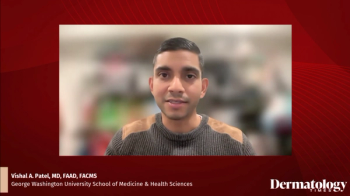
- Dermatology Times, April 2022 (Vol. 43. No. 4)
- Volume 43
- Issue 4
- Pages: 42
2022: Meeting the Challenges of Advanced BCC
Now, with an increasing emphasis on multidisciplinary tumor review boards and heightened expectations for pipeline drugs, physicians have new tools for building treatment plans that may push response rates beyond the 30% range.
Surgical options, especially Mohs surgery, and Hedgehog inhibitors have dominated the treatment landscape for advanced basal cell carcinoma (BCC). But not every patient is a good candidate for surgery, and, for others, tolerability and progression issues connected with Hedgehog inhibitors often pose challenges to long-term disease management. Now, with an increasing emphasis on multidisciplinary tumor review boards and heightened expectations for pipeline drugs, physicians have new tools for building treatment plans that may push response rates beyond the 30% range.
Three experts discussed these strategies in exclusive interviews with Dermatology Times®:
- Darrell S. Rigel, MD, MS, FAAD, a clinical professor and director of the Melanoma Surveillance Clinic at the Icahn School of Medicine at Mount Sinai in New York, New York
- Chrysalyne Schmults, MD, FAAD, a physician at Brigham and Women’s Hospital and an associate professor of dermatology at Harvard Medical School, both in Boston, Massachusetts
- Ann W. Silk, MD, MS, codirector of the Merkel Cell Carcinoma Center of Excellence in Boston, as well as a physician and an assistant professor of medicine at Harvard Medical School
Diagnosis and Multidisciplinary Team Management
The vast majority of the more than 1 million BCC cases each year in the United States are “easily cured” with surgical excision, with “only about” a 1% recurrence risk, Schmults and Rigel noted. In their experience, of the 1% of BCCs that do recur, most resolve with a second excision.
However, for cases that fail after multiple surgeries, Rigel, Silk, and Schmults all favored the formation of a cross-disciplinary team to create and monitor a holistic care plan. “What we call ‘advanced’ BCC can mean that it is beyond the skill set of a Mohs surgeon alone,” Rigel told Dermatology Times®. “You may reach a point where you are getting positive margins everywhere or where the lesion is large enough to require an inpatient procedure to try to repair it.”
If that is the case, Rigel suggested setting up a multidisciplinary management team that includes the dermatologist who made the advanced BCC diagnosis, a Mohs surgeon, a surgical oncologist, and a radiation oncologist.
Schmults recommended presenting a patient to a tumor board if they have a second recurrence. Depending on the case, a multidisciplinary approach to decision-making should involve dermatologists, oncologists, surgeons, endocrinologists, radiologists, and others, she said.
If a tumor board is not available, she advised opening a dialogue with colleagues in surgery and radiation oncology to discuss nonsurgical options or the possible benefit of off-label adjuvant therapies after another surgery. She also noted that there are no FDA-approved adjuvant therapies for BCC with a high risk of recurrence.
Silk emphasized the importance of the radiologist in multidisciplinary care. “In-transit metastases can often be hard to spot on imaging if you are not looking for them,” she noted. “CT scans of head and neck anatomy can be surprisingly hard to read. If there is a recurrence, a radiologist who is familiar with the patient can tell if it is an infield recurrence, a marginal recurrence, or another type of recurrence.”
Schmults agreed, noting a recent case from a tumor board at which a patient presented with what appeared to be a resectable lesion. “However, when the radiologists looked through the image chain, they found that surgery would be over a much larger area than initially thought, which helped steer us away from a surgical approach,” she said.
Although building a multidisciplinary team is key, Rigel urged dermatologists to remember that they are the patient’s first point of contact. “Even if you are not the physician prescribing the treatment, you have to understand that the patient will have the conversation about treatment options with you before you refer them,” he told Dermatology Times®.
He emphasized the importance of making sure the dermatologist is knowledgeable enough, particularly regarding medications, to talk the patient through the risks and rewards of possible management strategies.
Nonsurgical Solutions
A deeper knowledge of drug therapies is essential, particularly for patients who are not ideal candidates for surgery. Schmults favors nonsurgical solutions for patients who:
- have failed more than 2 surgical attempts;
- present with very large tumors and, thus, a high rate of morbidity from surgery;
- face anesthetic-related risk, especially if tumor excision will require lengthy surgical reconstruction; and
- have late-presenting disease.
“Other candidates for nonsurgical therapies include patients who present with multiple advanced lesions,” Rigel added. “You really can’t surgically remove all of them. There are also those who have had a number of basal cells in the past, even beyond people with basal cell nevus syndrome. They may have had multiple surgeries already, and they’re just tired of surgery; they’ve had radiation; they’ve had cryotherapy. They’ve had everything you can think of, and they’re looking for a medical option. And that’s another reason why you might go to a medical approach vs a surgical approach.”
Schmults pointed out that FDA-approved Hedgehog inhibitors vismodegib and sonidegib have been staples in treating advanced BCC. Although their 30% response rate is good in this context, the range of adverse effects (AEs) and the long-term care regimen have been a challenge for physicians and patients alike.
“These are tough drugs. The difficulty with these drugs is that if you stop them, almost all the patients will recur, so the patient ends up being on prolonged therapy with these oral agents. And these agents are pretty poorly tolerated, especially over the long term with a daily dosing regimen,” Schmults said.
Alopecia is nearly universal, according to Silk. That can mean thinning of the scalp hair but also extend to complete hair loss, including the eyebrows. However, she noted that muscle spasms are probably the most bothersome AE. “They happen at night, and they come without warning,” Silk said. “They’re quite painful for the patient. We don’t really have a good work-around for this.” Weight loss stemming from dysgeusia is another common complaint.
The combination of AEs often leads to lack of tolerability and to drug holidays. “To combat these AEs, physicians have worked with several different intermittent dosing regimens, where patients will be on drug for 1 or 2 weeks, then off drug for 1 or 2 weeks in this kind of cyclic repetitive pulse dosing regimen,” Rigel said.
According to Schmults and Silk, the recently approved PD-1 antibody cemiplimab (Libtayo; Sanofi and Regeneron Pharmaceuticals) could deliver efficacy with improved tolerability. “It is exciting that we have a drug now with anti–PD-1 therapy that’s FDA approved, so we have something beyond the Hedgehog inhibitors,” she said. “I think now the discussion with a patient is a little more nuanced because they do have more than 1 option. We can talk with our patients in some detail about the common [AEs] of Hedgehog inhibitor therapy and see if they would rather consider a drug that has a shorter track record in basal cell carcinoma with anti–PD-1 therapy.
“Cemiplimab is better tolerated in general, but it’s unclear if its long-term efficacy is going to be equal to that of the Hedgehog inhibitors,” she continued. “It is the preferred option, though, because with Hedgehog inhibitor therapy, it’s generally for life. When we stop Hedgehog inhibitors for advanced BCC, those tumors tend to grow back. And there may be, at least based on data with other cancers, some chance of long-term remission or cure with anti–PD-1 therapy, although that’s yet to be demonstrated in basal cell carcinoma.”
New Approaches on the Horizon
“We’ve seen that classical chemotherapy has not been effective for treating advanced BCC, so the immunotherapy approach has been the one that has changed things over the past few years,” Rigel said. “Right now, Hedgehog inhibitors and PD-1 inhibitors are the tools we have at our disposal. We are hoping to get some new immunologic approaches, and we are beginning to better understand the growth pathways for BCC. I think as we move forward, we’re going to be able to discover a different pathway that is more optimized for treating BCC as well as having fewer [AEs].”
Even with the 2 current immune pathways through which BCC is treated, many unknowns remain—so there is potential to use Hedgehog and PD-1 inhibitors in ways that might be more effective or minimize AEs. Schmults noted that the rarity of advanced BCC causes challenges in research. “It may take multiple centers and years to collect enough patients to study these indications effectively,” she said.
At the moment, there may be more questions than answers regarding these treatments. “We do not know if putting patients on a PD-1 inhibitor, then moving to a Hedgehog inhibitor or combining them, may be more effective,” Schmults said. “We do not know if PD-1 inhibitors can match the efficacy of Hedgehog inhibitors. Some research suggests, based on data from other cancers, that there may be a chance of long-term remission or cure with anti–PD-1 therapy, but that is yet to be demonstrated with BCC.”
Near term, Rigel would like to see answers that involve combination therapy: “We are seeing this in a melanoma where they are using 2 and even 3 combination therapies and are getting better outcomes with fewer [AEs].” He said he would like to see similar results for BCC.
On the armamentarium wish list for Silk and Schmults: better options for treating solid organ transplant recipients. They see immunotherapy as almost a last resort for this population, forcing doctors to return to older, less effective therapies unless a tumor leads to such poor quality of life that the medical team and patient feel it is worth the risk of organ rejection, which Schmults estimates at about 50%. She noted, however, that current therapies might minimize rejection risk: “What we’re learning from our kidney transplant patients is that using prednisone around the time of the infusion—I think it is the day before, day of, and for a few days after—may possibly be reducing the risk of rejection, but that has not yet been studied in other transplanted organs.”
Disclosures
Rigel is an advisory board member of, speaker for, and/or has received grants/research funding from Almirall, Beiersdorf, Castle Biosciences, DermTech, Ferndale Laboratories, SciBase, and VYNE Therapeutics.
Schmults is an advisory board member of, speaker for, and/or has received grants/research funding from American Society for Dermatologic Surgery, Castle Biosciences, Genentech, InflaRx, International Society for Dermatologic Surgery, Merck & Co, National Comprehensive Cancer Network, National Institutes of Health, Novartis, Regeneron, and Skin Cancer Outcomes Consortium.
Silk received grants/research funding from Regeneron.
Articles in this issue
over 3 years ago
Microneedling Misconceptionsover 3 years ago
Cost of Copies Prompts a Lawsuitover 3 years ago
Diverse Perspectives in Medical Aesthetics Matter More Than Everover 3 years ago
Cellular Grafting in Vitiligoover 3 years ago
Polish Skills to Treat Nail Disordersover 3 years ago
Identifying Diagnostic Bias in Skin of Colorover 3 years ago
Machine Learning to Identify Biomarkers in ADover 3 years ago
Effect of Joint Pain on Analgesic Use in Patients with Psoriasisover 3 years ago
Linking Psoriasis and Cardiometabolic DiseaseNewsletter
Like what you’re reading? Subscribe to Dermatology Times for weekly updates on therapies, innovations, and real-world practice tips.


















